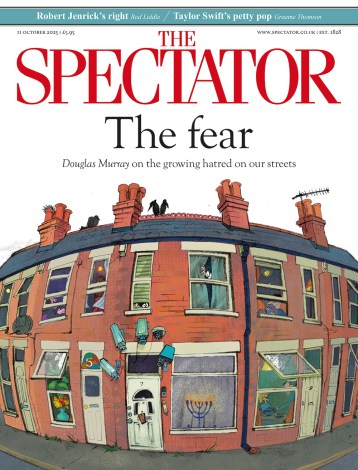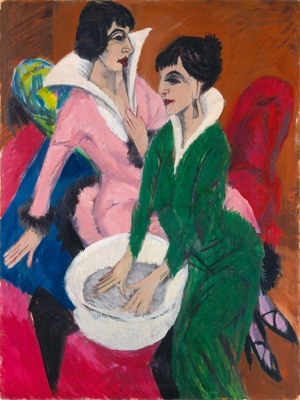Under the statue of Charles III in the Puerta del Sol a hellfire preacher is competing for custom with a mariachi band. ‘Porque la paga del pecado es muerte!’ he shouts. ‘Ay, ay, ay, ay,’ they sing, ‘porque cantando se alegran, cielito lindo, los corazones.’ The weather is with the preacher: the cielo is not lindo. The El Greco cumulonimbus overhead flickers with lightning as God adds a rumble of thunder to the mix.
Apart from the angry heavens and the five police vans lined up opposite — for prevención, they tell me — there’s little sign that Spain is on the brink. The leaning towers of Bankia may be tottering, but to judge from the queues outside the Prado the culture industry has not been affected. On a free Sunday evening they stretch around the block, so I plump for the airy spaces of the fee-charging Museo Thyssen-Bornemisza at the northern apex of Madrid’s ‘golden triangle’ of galleries.
When Baron ‘Heini’ Thyssen Bornemisza chose Madrid as a permanent home for his art collection in 1992, he saw a gap in the market. The Spanish don’t go in for one-stop shops. Madrid is peppered with small specialist outlets — a Casa del Fumador, a Casa del Bacalao, a Museo del Jamòn, even a shop dedicated to violet sweets — and its only department store is called El Corte Inglés. Unlike our National Gallery, the Prado makes no attempt to be encyclopedic. The result of four centuries of royal collecting, its holdings are full of art-historical gaps which the Museo Thyssen-Bornemisza helps to plug.
The 800 works on display in the neoclassical Palacio de Villahermosa on the Paseo del Prado offer a shorter encyclopedic introduction to western art from the Italian Primitives to American Pop. Inevitably, the quality is uneven — today’s collectors can’t always be choosers. Some old masters look iffy, some modern ones odd. Gauguin is not immediately recognisable in the Pissarroesque impressionism of ‘A Street in Rouen’ (1884) nor Picasso in the rather awkward abstraction of ‘The Harvesters’ (1907), before Cubism had shed its puppy fat. But there’s a fine late Cézanne ‘Portrait of a Peasant’ (1905–6), some wonderful Lautrecs — Yvette Guilbert, all nose and gloves, once hung in Heini’s bedroom — and a colourful bunch of German Expressionists. Among the old masters are an exquisite ‘Christ and the Samaritan Woman’ (1310/11) from the predella of Duccio’s ‘Maestà’ and an unusually sweet Caravaggio of ‘Saint Catherine of Alexandria’ (c.1598). Sensibly, there are few Spanish paintings. No point in competing with the Prado.
If the Thyssen-Bornemisza serves ‘raciones’, the Prado’s helpings are ‘porciones’, supersized. Nothing quite prepares you for the collection’s richness. Imagine our own Royal Collection if Charles I’s pictures had not been sold (with several gems, including Mantegna’s ‘Death of the Virgin’ and Dürer’s ‘Self-Portrait’, snapped up by Philip IV of Spain and now in the Prado). Imagine, next, that the English court had had the services of a Velázquez and a Goya; that our overseas dominions had given us privileged access to the pick of Netherlandish art; and that our king had had the nous to send Velázquez on an art-buying tour of Italy. Now imagine this Royal Collection belonging to the state. The Prado owns a treasure trove of works by Titian, a cornucopia of paintings by Rubens, Rogier van der Weyden’s ‘Descent from the Cross’, Bosch’s ‘Garden of Earthly Delights’, and — at its Spanish core, alongside masterpieces by El Greco, Cotán, Ribera, Zurbarán, Murillo and Meléndez — two entire galleries’ worth of paintings by Velázquez and Goya.
As court painter, Velázquez’s official duty was to portray the different faces of the monarchy: Philip IV at a table in administrative subfusc, on horseback in armour, in hunting dress with gun and dog, always with the same long face, handlebar moustaches and incongruous kiss curls. Outside that remit, Velázquez’s versatility was boundless. What other royal portraitist applied himself with equal aplomb to religious subjects, classical allegory, low life, still life and animal portraiture? His ‘Head of a Stag’ (1634) makes Landseer’s ‘Monarch of the Glen’ look like Bambi. His versatility was both nurtured and constrained by the court, and it’s as a bird in a gilded cage that he depicts himself in ‘Las Meninas’ (1656), looking confidently out of the claustrophobic space of the canvas at us, his keepers, with a slashed silk sleeve carelessly nudging his heaped palette.
Two centuries on, with the monarchy in decline, Goya took a radically different approach. Like all his subjects, Goya’s royals were cut down to size. Charles III in ‘Hunting Dress’ (c.1786) is a gnarled old-timer with a bulbous nose, ‘Queen Maria Luisa on Horseback’ (1799) a smug-looking matron, her consort Charles IV merely benign. The ‘Treacherous King’ Ferdinand VII, who abolished the 1812 Constitution but founded the Prado, wears his robes of state like fancy dress and grips his staff of command like a knobkerry. Incredible to think that the near life-sized firing squad of Goya’s ‘The Third of May, 1808, in Madrid’ (1814) was painted for Ferdinand’s palace apartments. It’s a hard picture to share a room with, though it’s a party compared with the ‘Black Paintings’ with which Goya shared his last few years in Spain. But a trip to the suburbs to see his 1798 fresco cycle in the Ermita de San Antonio de la Florida — now the artist’s mausoleum — lifts the gloom. (Changing metro on the way back, I pass an ad for Goya tinned beans. Spain wears its artistic heritage very lightly — to the Spanish housewife, beans means Goya.)
It’s with Goya that the story of modern art starts in the Museo Nacional Centro de Arte Reina Sofia at the southern tip of the golden triangle. Split between the former hospital of San Carlos built by Charles III and a new building designed by Jean Nouvel, and divided into three collections on different floors of different buildings, it aims to avoid ‘a canonical view of history’ and only confuses.
I headed straight for ‘Collection 1, The Irruption of the 20th Century: Utopias and Conflicts (1900–1945)’ — or so I thought — missed the beginning and took up the story in a room called ‘Words in Freedom, Surrealism and Magnetic Fields’. A maze of rooms of Miró, Masson, Tanguy, Ernst, Magritte and Dalí later — the ‘Face of the Great Masturbator’ (1929) seemed haunted by the spectre of Bosch — I reached the climax of the story, Picasso’s ‘Guernica’ (1937). The large gallery of exhaustive preparatory works exploring different expressions of grief is no preparation for the full impact of this sustained ululation in the flesh.
No time to answer the question posed by ‘Collection 2 — Is the War Over? Art in a Divided World (1945–1968)’ before my final gallery stop, the Fundación Mapfre at the top of the Paseo del Prado. With its increasingly ambitious exhibition programme, this new gallery space opened by the Spanish insurance giant in 2008 is bidding to redesign Madrid’s golden triangle as a rhomboid. Until 2 September it hosts Ernst Ludwig Kirchner (1880–1938), a major retrospective for which it is the only venue. David is taking on the Goliaths. ‘Spain doesn’t have a museum dedicated exclusively to modern art,’ claims director Pa blo Jiménez Burillo. Tell that to the Reina Sofia. On the golden rhomboid, the war has just begun.






Comments